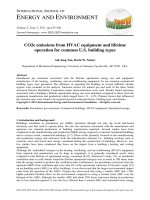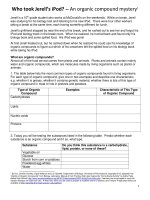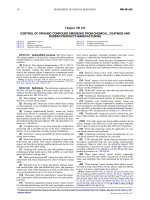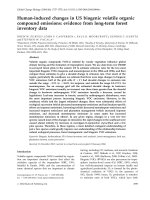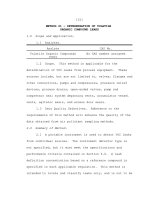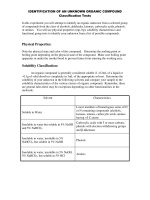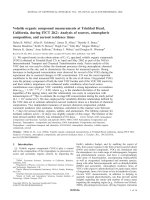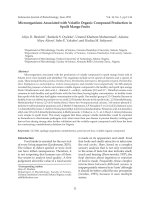Volatile Organic Compound Emissions from Automobile Refinishing -- Background Information for Promulgated Standards pot
Bạn đang xem bản rút gọn của tài liệu. Xem và tải ngay bản đầy đủ của tài liệu tại đây (98.46 KB, 51 trang )
Volatile Organic Compound
Emissions from Automobile
Refinishing Background
Information for Promulgated Standards
E P A
Air
United States
Environmental Protection
Agency
Office of Air Quality
Planning and Standards
Research Triangle Park NC 27711
EPA-453/R-96-011b
August 1998
EPA-453/R-96-011b
Emission Standards Division
U.S. ENVIRONMENTAL PROTECTION AGENCY
Office of Air and Radiation
Office of Air Quality Planning and Standards
Research Triangle Park, North Carolina 27711
August 1998
Volatile Organic Compound Emissions
from Automobile Refinishing
Background Information for
Promulgated Standards
DISCLAIMER
This report has been reviewed by the Emission Standards Division
of the Office of Air Quality Planning and Standards, EPA, and
approved for publication. Mention of trade names or commercial
products is not intended to constitute endorsement or
recommendation for use. Copies of this report are available from
National Technical Information Services, 5285 Port Royal Road,
Springfield, VA 22161.
iii
TABLE OF CONTENTS
Page
1.0 LIST OF COMMENTERS 1-1
2.0 SUMMARY OF PUBLIC COMMENTS 2-1
2.1 LEGISLATIVE AUTHORITY 2-1
2.2 PROPOSED STANDARDS 2-4
2.2.1 Applicability 2-4
2.2.2 Definitions 2-14
2.2.3 Standards 2-16
2.2.4 Compliance Requirements 2-22
2.2.5 Labeling Requirements 2-23
2.2.6 Reporting Requirements 2-24
2.2.7 Variances 2-25
2.2.8 Test Methods 2-26
2.2.9 Miscellaneous 2-28
LIST OF TABLES
1-1 LIST OF COMMENTERS ON PROPOSED NATIONAL EMISSION
STANDARDS FOR AUTOMOBILE REFINISH COATINGS 1-2
1-1
1.0 LIST OF COMMENTERS
A list of the commenters, their affiliations, and the EPA
docket number assigned to their correspondence is given in
table 1-1.
1-2
TABLE 1-1. LIST OF COMMENTERS ON PROPOSED NATIONAL
EMISSION STANDARDS FOR AUTOMOBILE REFINISH COATINGS
Docket number Commenter and affiliation
a
IV-D-01 Dr. K.E. Hine
Director of Safety, Health, and
Environmental Affairs
ICI Paints
Westlake, Ohio
IV-D-02 H. Hieb
Spokesman
Central Coast Independent
Autobody Coalition
Santa Maria, California
IV-D-03 R.T. Winstead
Roxboro, North Carolina
IV-D-04 L. Simpson, V. Pratt, and K. Kerr
Florida International University
Student Body
IV-D-05 B.M. Richards
Manager, Automotive Refinishing
Coatings R&D
BASF Corporation
Whitehouse, Ohio
IV-D-06 M.S. Kruzer
Manager, Regulatory Affairs
The Sherwin-Williams Company
Cleveland, Ohio
IV-D-07 J.A. Hackney
Technical Services & Environmental
Regulatory Affairs
American Standox, Inc.
Plymouth, Michigan
IV-D-08 D.L. Stein
Senior Product Responsibility Specialist
3M Company
Saint Paul, Minnesota
IV-D-09 B. Mathur
Chief, Bureau of Air
State of Illinois Environmental
Protection Agency
Springfield, Illinois
TABLE 1-1. LIST OF COMMENTERS ON PROPOSED NATIONAL
EMISSION STANDARDS FOR AUTOMOBILE REFINISH COATINGS
(CONTINUED)
Docket number Commenter and affiliation
a
1-3
IV-D-10 B.A. Kwetz
Director, Division of Air Quality
Control
Commonwealth of Massachusetts
Department of Environmental Protection
Boston, Massachusetts
IV-D-11 L. Cole
Executive Vice President and
General Manager
Surface Protection Industries, Inc.
Los Angeles, California
IV-D-12 D. Stringham
Director, Regulatory and State
Government Affairs
Safety-Kleen
Elgin, Illinois
IV-D-13 K. Schultz
Environmental Consultant
Dupont Automotive
Wilmington, Delaware
IV-D-14 J. Sell
Senior Counsel
National Paint & Coatings Association
Washington, DC
IV-D-15 B. Adler
Adler's Antique Autos, Inc.
Stephentown, New York
IV-D-16 Automotive Services Association
Bedford, Texas
IV-D-17 D.I. Greenhaus
Director, Environment, Health and Safety
National Automobile Dealers Association
McLean, Virginia
IV-F-01 Michael Callahan
Safety-Kleen Corporation
Chicago, Illinois
TABLE 1-1. LIST OF COMMENTERS ON PROPOSED NATIONAL
EMISSION STANDARDS FOR AUTOMOBILE REFINISH COATINGS
(CONTINUED)
Docket number Commenter and affiliation
a
1-4
IV-F-01 Howard Berman
The Jefferson Group
VI-B-01 K. Schultz
Environmental Consultant
Dupont Automotive
Wilmington, Delaware
VI-B-02 Herb Morrison
BASF Corporation
Whitehouse, Ohio
VI-B-03 Bernard Zysman
Technical Services Specialist
Occidental Chemical Corporation
Niagara Falls, New York
VI-B-04 Ronald Walton
Clariant Corporation
Charlotte, North Carolina
VI-B-05 James Kantola
Safety, Health & Environmental Manager
ICI Paints
Westlake, Ohio
VI-B-06 Douglas Greenhaus
Director, Environment, Health & Safety
National Automobile Dealers Association
McLean, Virginia
VI-B-07 Jim Sell
Senior Counsel
National Paint & Coatings Association
Washington, DC
VI-B-09 B. Mathur
Chief, Bureau of Air
State of Illinois Environmental
Protection Agency
Springfield, Illinois
a The docket number for this rule is A-95-18. Category IV-D
includes public comments on the April 30, 1996, proposed rule;
Category IV-F includes comments made at the public hearing;
1-5
Category VI-B includes comments on the December 30, 1997,
supplemental proposed rule.
2-1
2.0 SUMMARY OF PUBLIC COMMENTS
The EPA received a total of 26 comment letters on the
proposed standards and the technical support document for the
proposed standards. The EPA also received comments during the
public hearing for this rule. This document contains summaries
and responses to comments mainly concerning the provisions of the
proposed automobile refinish coatings rule. However, at the time
of proposal of the rule, the EPA specifically requested comment
on certain topics concerning section 183(e) of the Clean Air Act
(Act) in general. Therefore, those comments and responses are
discussed in this document as well. In order to avoid
duplication, most comments that pertain to the EPA’s study,
Report to Congress, and schedule for regulations under
section 183(e) of the Act are discussed in a separate comment
response document, Response to Comments on Section 183(e) Study
and Report to Congress (EPA-453/R-98-007) also referred to as the
183-BID.
The comments have been categorized under the following
topics:
Section 183(e) Requirements
Applicability
Definitions
Standards
Compliance Requirements
Labeling Requirements
Reporting Requirements
Variances
Test Methods
Cost Impacts
Miscellaneous
2.1 LEGISLATIVE AUTHORITY
Comment: Several commenters (IV-D-09, IV-D-10, IV-D-14)
responded to the EPA’s request for comments on the use of control
techniques guidelines (CTG) to address automobile refinish
coatings. These commenters support a national rule instead of
2-2
CTG-based State rules. One commenter (IV-D-09) stated a CTG-
based approach would complicate rule development and enforcement
because States could adopt different rules. One commenter (IV-D-
14) stated that in light of the national distribution system of
refinish coatings, the large number of diverse coatings used by
the industry, and the need to avoid differing and potentially
conflicting State regulations that would disrupt the orderly
interstate movement of coatings, a national rule approach is
appropriate for automobile refinish coatings. Another commenter
(IV-D-09) stated that a national rule will reduce VOC emissions
in ozone attainment areas that, because of pollutant transport,
contribute to ozone formation in nonattainment areas.
Response: The EPA has concluded that a national rule is the
more effective approach for reducing emissions from consumer
products, automobile refinish coatings, and architectural
coatings. First, the EPA believes that a national rule is an
appropriate means to deal with the issue of products that are, by
their nature, easily transported across area boundaries and
typically are widely distributed and are used by widely varied
types of end-users. For many such products, the end-user may use
them in different locations from day-to-day. Because the
products themselves are easily transportable, a national rule
would preempt opportunities for end-users to purchase such
consumer and commercial products in attainment areas and then use
them in nonattainment areas, thereby circumventing the
regulations and undermining the intended decrease in VOC
emissions. The EPA, therefore, believes that a national rule
with applicability to products regardless of where they are
marketed is a reasonable means to ensure that the regulations
result in the requisite degree of VOC emission reduction.
Second, the EPA believes that rules applicable only in
nonattainment areas would be unnecessarily complex and burdensome
for the regulated entities to comply with and for the Agency to
2-3
administer. The potentially regulated entities under
section 183(e) of the Act are the manufacturers, processors,
wholesale distributors, or importers of consumer and commercial
products. Any regulations that would differentiate between
products destined for attainment and nonattainment areas would
require that regulated entities have sufficient ability to track
their products and control their distribution, sale, and ultimate
use to ensure that only compliant products go to nonattainment
areas. Although the EPA recognizes that some product lines in
some product categories may only be distributed regionally in
areas that are already in attainment, the large majority of the
product lines will be distributed nationally. Regulations
targeted only at nonattainment areas could thus impose
significant additional burdens upon regulated entities to achieve
the goals of section 183(e) of the Act.
By comparison, existing State regulations in some instances
apply to a broader range of entities, including retail
distributors and end users. Given the limitations of
section 183(e) of the Act as to regulated entities, the EPA
believes that regulations applicable to both attainment areas and
nonattainment areas are a reasonable means to ensure use of
complying products where necessary, while avoiding potentially
burdensome impacts and less reliable mechanisms to achieve the
goals of section 183(e). Several of the trade associations of
the industries for whom the EPA has proposed national rules
(i.e., architectural coatings, consumer products, and automobile
refinish coatings) have supported national rules that apply to
all areas as the most efficient regulatory mechanism from the
perspective of marketing and distribution of products. The EPA’s
consideration of this factor, however, is not meant to imply that
it would be inappropriate for States to develop more stringent
levels of controls where necessary to attain the ozone standard.
2-4
Instead, the national standard is expected to reduce the number
of States needing to develop separate rules for these categories.
Third, the EPA believes that national rules with nationwide
applicability may help to mitigate the impact of ozone and ozone
precursor transport across some area boundaries. Recent modeling
performed by OTAG and others suggests that in some circumstances
VOCs emitted outside nonattainment area boundaries can contribute
to ozone pollution in nonattainment areas, e.g., by traveling
relatively short distances into neighboring nonattainment areas.
The EPA has recognized the potential for VOC transport in the
December 29, 1997, Guidance for Implementing the 1-hour Ozone and
Pre-Existing PM NAAQS concerning credit for VOC emission
10
reductions towards rate of progress requirements. The guidance
indicates that the EPA may give credit for VOC reductions within
100 kilometers of nonattainment areas. In addition, the
June 1997 recommendations made by OTAG supported the EPA’s use of
VOC regulations that apply to both nonattainment and attainment
areas to implement section 183(e) of the Act for certain
products. The particular product categories OTAG cited for
national VOC regulations are automobile refinishing coatings,
consumer products, and architectural coatings. The EPA believes
that regulation of products in attainment areas is necessary to
mitigate VOC emissions that have the potential to contribute to
ozone nonattainment in accordance with section 183(e) of the Act.
Finally, the arguments in this section supporting the EPA’s
authority and rationale for regulating both nonattainment and
attainment areas under section 183(e) of the Act are not intended
to imply that the EPA would not consider using its discretion to
develop a CTG (which would affect VOC emissions only in
nonattainment areas) for a category in lieu of a regulation. The
EPA recognizes that patterns of distribution and use will vary
among categories of products. Therefore, the EPA intends to use
its discretion to determine the most efficient and effective mode
2-5
of regulation for each of the categories listed for regulation
under section 183(e) of the Act.
2.2 PROPOSED STANDARDS
2.2.1 Applicability
Comment: Several commenters (IV-D-02, IV-D-03, IV-D-06, IV-
D-13, IV-D-14, IV-D-15) claimed that lacquer topcoats should be
exempt from the rule because they account for only 5-10% of
coating usage, and their use is decreasing because automobile
manufacturers use other coating types on new automobiles. These
commenters indicated that lacquers are used mainly by hobbyists
who wish to restore vehicles to their original condition,
including the paint finish. One commenter (IV-D-13) stated that
the use of lacquers to refinish modern vehicles is untenable
because of inferior durability and aesthetics. Another commenter
(IV-D-09) suggested that the EPA should classify lacquer coatings
as specialty coatings and consider limiting their production,
since an exemption for lacquers would create inconsistencies
between the national rule and State rules that do not exempt
them. The commenter stated that limiting lacquer production
would aid in the compliance with State rules.
Response: The EPA has determined that it is appropriate to
exempt lacquer topcoats from the final rule. The EPA agrees
lacquer topcoats are less desirable than other coating types for
refinishing modern automobiles, and that their use is therefore
not likely to increase since they are not used on new
automobiles. Lacquers are not as durable as other coatings.
Since they dry by solvent evaporation alone (rather than through
chemical crosslinking), they are not resistant to solvent attack.
Although other coatings generally can be used to refinish antique
and classic automobiles, the finish would not be the “original”
finish desired by users in this niche of automobile refinishing.
The EPA exempted lacquer topcoats from the final rule because
their use is decreasing, their contribution to the total VOC
2-6
emissions is small, they fill a niche in the automobile refinish
industry, and they cannot be reformulated to meet the VOC content
limit for topcoats.
Including lacquer topcoats in a specialty coating category
and limiting their production, as suggested by one commenter,
does not appear to be a viable option. First, production limits
set significantly below current usage levels would cause
shortages of lacquer topcoats. Such shortages would restrict
consumer access to the product. Second, production limits set at
or near current usage levels would be equivalent to an exemption,
since lacquer topcoat usage is not likely to increase. The
additional recordkeeping necessary to make a production limit
enforceable would be burdensome on both regulated entities and
the EPA. For these reasons, the EPA decided against the creation
of a specialty category with limits on production for lacquer
topcoats.
One commenter noted that an exemption would lead to an
inconsistency between State and federal rules for this coating
type. The EPA acknowledges that an exemption for lacquer
topcoats under the national rule may make the rule less stringent
than some State rules, but the EPA notes that States may still
choose to be more stringent than the national rule by the
inclusion of such coatings in their own rules.
Comment: One commenter (IV-D-01) disagreed with the EPA’s
statement that the distribution of coatings has no effect on
whether compliant coatings are used. The commenter stated that
distributors may bring noncompliant products into the United
States via Mexico or Canada without a manufacturer’s knowledge.
Response: The example given by the commenter appears to be
one of importation rather than distribution. Both the proposed
and final rule apply to importers of automobile refinish coatings
and coating components and thus require importers to ensure that
2-7
their recommended use of coatings or coating components for
automobile refinishing would be compliant.
Comment: Several commenters (IV-D-01, IV-D-05, IV-D-06, IV-
D-07, IV-D-09, IV-D-10, IV-D-13, IV-D-14) supported including
manufacturers and importers of automobile refinish coating
components, such as thinners and hardeners, as regulated
entities. The commenters stated that excluding coating component
manufacturers and importers would likely result in the use of
coatings with VOC levels higher than the proposed standards,
since these components would not be required to be part of a
compliant coating system under the proposed rule.
Response: The EPA agrees with the concern raised by these
commenters. Regulated entities under the April 30, 1996,
proposed rule included only manufacturers and importers of
complete automobile refinish coatings. The VOC content of an
automobile refinish coating depends, however, on the VOC content
levels of all components that make up the coating. Coating users
sometimes combine components made by multiple manufacturers when
preparing a coating. Since components themselves are not
coatings, a manufacturer who produces only hardeners, for
example, would not have been subject to the April 1996 proposed
rule. Such a manufacturer could recommend that its hardener be
combined with components of other manufacturers, possibly
resulting in a coating that exceeds the VOC content standards of
the rule. Such a situation could essentially undermine the VOC
emission reductions of the rule.
To address the concern raised by these commenters, the EPA
proposed in a supplemental notice (December 30, 1997, 62 FR
67784) to include as regulated entities all manufacturers and
importers of automobile refinish coatings or coating components.
The EPA also proposed a mechanism for determining compliance with
the rule for coatings consisting of components made or imported
by multiple entities. Under this approach, manufacturers and
2-8
importers of coatings or coating components must comply with the
VOC content limits for complete coatings by calculating the VOC
content of coatings that result from the use of their components
in accordance with their recommendations.
Determining compliance for coatings consisting of components
made or imported by one regulated entity is relatively easy. In
general, compliance would be determined by "spot checking," where
the EPA (or the regulated entity, if requested by the EPA) would
obtain coating components, mix the components in the ratios
recommended by the regulated entity (on the containers or in any
product literature), and analyze the resulting coating using
Method 24. The EPA considered requiring regulated entities to
perform VOC testing of their coatings on a regular basis (e.g.,
every nth batch) to demonstrate compliance with the rule, but
believes that such a requirement would be economically
burdensome. The EPA believes that random spot checks will be
adequate to encourage regulated entities to assure that all of
their coating batches are compliant.
Determining the compliance of coatings that consist of
components made or imported by multiple regulated entities is
more difficult. The EPA considered several options for
determining compliance in these cases. The EPA considered
requiring regulated entities (that recommend the use of their
components with those of other regulated entities) to use Method
24 to test the coatings resulting from their recommendations.
Using this information, the entities could establish the maximum
allowable VOC content of their components, and the EPA would spot
check components to determine compliance. However, the EPA
currently has no method for determining the VOC content of
individual components. Also, the VOC content of a coating is not
simply the sum of the VOC contents its components, so component
VOC content is not necessarily an indicator of the VOC content of
the overall coating. Therefore, the EPA believes it is
2-9
technically infeasible to determine compliance using component
VOC content information.
Because of the technical infeasibility of the approach
described above, the EPA has concluded that the responsibility
for coatings should be based on product recommendations. In
other words, if an entity recommends a combination of components
(made or imported by one or more regulated entities), then that
entity is responsible for the compliance of the resulting
coating. There may be cases where a coating resulting from an
entity's recommendation is noncompliant because of the components
of other regulated entities. Since this occurrence may be beyond
the control of the recommending entity, the Agency determined
that it would be appropriate to provide regulated entities with a
means to establish their compliance with the rule, and the Agency
solicited comments on such a mechanism. In this event, the final
rule provides regulated entities the opportunity to submit new or
existing Method 24 test data demonstrating the compliance of the
coating resulting from their recommendation. This option is
technically feasible, and is appropriate since compliance is
determined in essentially the same way for all regulated
entities.
It is important to note that regulated entities would be
liable only for the VOC content of the coatings that result from
their recommendations. For example, if a regulated entity
recommends that three of its coating components be combined and
used in automobile refinishing, it is responsible for the coating
that results from that combination. If a regulated entity
recommends the substitution of one of its components for that of
another regulated entity, the former entity is responsible for
the resulting coating. A regulated entity is not responsible for
coatings resulting from the recommendations of others, even if
such recommendations involve the use of components of that
regulated entity.
2-10
Comment: One commenter (VI-B-04) requested clarification of
the term “component.” The commenter questioned whether raw
materials, such as dry pigments, are considered to be components,
and whether raw material manufacturers and importers would be
regulated entities under the rule.
Response: The EPA did not intend to include raw material
manufacturers or importers as regulated entities. Although some
raw materials may affect the VOC content of coating components,
the VOC content of a coating is determined by the manufacturer
that uses raw materials in the production of coating components
supplied to distributors for sale and application by end-users.
The EPA intends to regulate automobile refinish coating component
manufacturers and importers that market such components to
distributors and end-users in the automobile refinish industry.
Raw material suppliers do not make recommendations to end-users
of coatings, but make recommendations to manufacturers of coating
components regarding the possible use of raw materials in the
production of such components. The EPA has included in the final
rule a definition for automobile refinish coating component that
excludes raw materials.
Comment: Several commenters (IV-D-06, IV-D-07, VI-B-01, VI-
B-02, VI-B-05, VI-B-06, VI-B-07) supported exempting touch-up
coatings from the rule. Some of these commenters stated such
coatings are sold in small containers, applied by brush, and used
routinely for minor scratches or nicks that do not require more
extensive repair. One commenter (VI-B-07) stated that the
definition of touch-up coatings should not include an upper limit
on container size. The commenter stated that such a limit would
impose an artificial restriction on the selection of the most
economical container size, and would serve no purpose.
Response: Touch-up coatings differ from typical refinish
topcoats in that they are typically used by automobile owners to
repair minor scratches or nicks, require no mixing prior to
2-11
application, and are sold in small containers. Most touch-up
coatings are lacquers, which are exempt from the final rule.
Since touch-up coatings are an insignificant emissions source,
the EPA is exempting them in the final rule. The definition of
touch-up coatings in the final rule states that such coatings are
applied by brush, air-brush, or non-refillable aerosol can to
cover minor surface damage. This definition is very similar to
that included in the South Coast Air Quality Management District
Rule 1151. The EPA has no information indicating that touch-up
coatings are packaged in containers larger than eight ounces.
However, since the definition of such coatings states that they
are applied by brush, air-brush, or nonrefillable aerosol spray
can, it is unlikely that this coating category can be abused even
without a limit on container size. Therefore, the definition of
touch-up coatings in the final rule does not contain a limit on
container size.
Comment: Several commenters (IV-D-06, IV-D-07, IV-D-13, IV-
D-14) recommended exempting coatings used at training facilities
from the rule. The commenters stated such facilities are used to
train international coatings users, some of whom use coatings
that do not meet the VOC content standards of the proposed rule.
Response: Most international coating users trained in the
United States are from Mexico or Canada. The EPA has no
information indicating that coatings compliant with the national
rule cannot be used to train such users. Training for Canadian
users probably should be done with coatings compliant with the
national rule, since Canada is currently developing a similar
rule. The EPA is not exempting coatings or coating components
used at training facilities in the final rule.
Comment: One commenter (IV-D-07) requested clarification of
applicability of the rule to coatings that are imported into the
United States and then exported to another country.
2-12
Response: The EPA did not consider in the proposed rule the
scenario described by the commenter. Coatings manufactured in
this country for export were exempted because section 183(e) of
the Act contemplates regulation of products for sale or
distribution in the United States. The EPA does not consider it
necessary to regulate the VOC content of coatings that are
brought into the United States and subsequently shipped outside
of the United States. Therefore, the final rule includes an
exemption for coatings and coating components that are
manufactured in or outside the United States for sale or
distribution outside the United States.
Comment: One commenter (IV-D-13) questioned whether the
rule would apply only in the 48 contiguous states, or include the
District of Columbia, Alaska, Hawaii, Puerto Rico, Virgin
Islands, Guam, and American Samoa.
Response: All States and territories are covered by the
Act. Accordingly, this rule applies to the United States of
America, including the District of Columbia, Puerto Rico, the
Virgin Islands, Guam, American Samoa, and Commonwealth of the
Northern Mariana Islands.
Comment: One commenter (IV-D-13) stated that the term
”automobile refinish coating” needs to be more fully defined.
Specifically, the commenter questioned whether a coating having
the phrase “automotive finishes” in its brand name would be
considered an automobile refinish coating if no suggestion is
made on the label or in any product literature that the coating
be used for automobile refinishing.
Response: The final rule applies to automobile refinish
coating and coating component manufacturers and importers. The
final rule requires that coatings resulting from recommendations
for automobile refinish use made by manufacturers and importers
must comply with the VOC content limits of the rule. In some
product literature, the trade or brand name is the only
2-13
indication that a product is intended for automobile refinishing.
If the reference to automobile refinishing were allowed in the
trade or brand name of coatings that exceed the VOC content
standards, then noncompliant coatings could continue to be used
for automobile refinishing. The following definition was added
in the final rule for clarification:
automobile refinish coating component means any portion of a
coating, such as a reducer or thinner, hardener, additive,
etc., recommended (by its manufacturer or importer) to
distributors or end-users for automobile refinishing. The
raw materials used to produce the components that are mixed
by the end-user to prepare a coating for application are not
considered automobile refinish coating components. Any
reference to automobile refinishing made by a manufacturer
or importer on a container or in product literature
constitutes a recommendation for automobile refinishing.
Comment: One commenter (IV-D-02) questioned the exemption
for original equipment coating manufacturers. The commenter
stated: “autobody shops are not exempt, so why should coating
manufacturers and assembly line operations be exempt?”
Response: Coatings used by automobile manufacturers are
different from automobile refinish coatings. Separate
regulations address the automobile industry, including New Source
Performance Standards (40 CFR, Subpart MM), and requirements for
some new or modified sources to install Best Available Control
Technology (ozone attainment areas) or achieve the Lowest
Achievable Emission Rate (LAER) (ozone nonattainment areas).
Also, a source category for regulation under section 112(d) of
the Act includes auto and light duty truck surface coating. In
short, these types of automobile finishing operations are
regulated by other means to achieve emissions reductions.
Comment: One commenter (IV-D-06) stated that the definition
of “assembly line coating operations” was too restrictive because
it does not include situations where original coating finishes
are applied without having the vehicle conveyed along a moving
belt or track. The commenter stated that in the custom van
2-14
market an original finish is applied without using a moving belt
or track.
Response: In the proposed rule there was an exemption for
coatings that are manufactured for use by original equipment
manufacturers for assembly line coating operations. Since the
meaning of this exemption is not changed by removing the
reference to assembly line coating operations, this language has
been removed in the final rule. The exemption from the final
rule is for coatings manufactured or imported for use by original
equipment manufacturers. Since van customizers apply coatings to
a vehicle that already has an original finish applied by the van
manufacturer, coating application during van customization is
considered automobile refinishing.
Comment: One commenter (IV-D-13) stated that additives
should be exempt from the rule because there is no good mechanism
available to additive manufacturers to guarantee compliant
coatings when the end user uses additives. The commenter stated
when additives are used, only about 1 to 2 ounces per ready-to-
spray gallon are added. The commenter stated since the input of
additives on VOC is minimal, they should be exempt.
Response: For the purposes of the national rule, additives
are considered to be coating components. The VOC content limits
of the rule are for coatings prepared according to their mixing
instructions, including all components. As coating component
manufacturers or importers, additive manufacturers or importers
would only be potentially out of compliance if their
recommendation for use resulted in coatings that are
noncompliant.
2.2.2 Definitions
Comment: Several commenters (IV-D-01, IV-D-06, IV-D-07, IV-
D-13, IV-D-14 ) recommended the definition of specialty coatings
be revised to include the phrase “including but not limited to.”
The commenters stated that such an open-ended definition would
2-15
allow refinish coating manufacturers to continue to produce new
coatings compatible with new substrates and coatings of original
equipment manufacturers (OEM). Several of the commenters stated
that abuse of an open-ended definition is not likely because the
VOC limits of the rule are reasonable, giving coating users no
reason to use specialty coatings for purposes other than their
intended use.
Response: The EPA agrees that an open-ended definition for
specialty coatings would allow refinish coating manufacturers and
importers to produce (import) coatings compatible with new OEM
substrates and coatings; however, the EPA believes such a
definition could lead to abuse. Even with reasonable VOC limits,
an incentive to abuse an open-ended specialty coating definition
exists because noncompliant primers and topcoats could continue
to be used if they are recommended for a special purpose.
The rule allows coating manufacturers and importers to apply
for a variance if, for technical or economic reasons, they cannot
comply with the requirements of the rule. Such variances may be
obtained for new coatings that do not comply with the VOC content
standards. Variances are discussed more in section 2.2.7. An
open-ended definition of specialty coatings is not included in
the final rule.
Comment: Several commenters (IV-D-06, IV-D-13, IV-D-14)
stated the definition of specialty coatings should be revised to
include “cut-in” clearcoats or “jambing” clearcoats. The
commenters stated this coating is necessary for clearcoating door
jambs and other areas of automobiles where heavy contours, seams,
or protrusions make sanding, buffing, and polishing infeasible.
The commenters stated that the use of standard clearcoats is not
practical for these areas because they dry slower, have higher
film builds, and impact the gloss and texture of other areas (due
to overspray effects caused by the unique surface
configurations). Another commenter (IV-D-08) recommended the
2-16
addition of water hold-out coatings as a specialty coating, and
suggested the following definition from Rule 1151 of the South
Coast Air Quality Management District (SCAQMD):
A water hold-out coating is a coating applied to the
interior cavity areas of doors, quarter panels and rocker
panels for the purpose of corrosion resistance to prolonged
water exposure.
Response: The final rule includes cut-in, or jambing,
clearcoats as specialty coatings. Since jambing clearcoats are
ready-to-spray, they are defined as ready-to-spray clearcoats
applied to surfaces such as door jambs and trunk and hood edges.
Water hold-out coatings are used as rust preventers, and are
applied by aerosol spray or application wand to specific areas
that are difficult to reach. Water hold-out coatings are
included in the specialty coating category of the final rule, and
the definition used in SCAQMD Rule 1151 is used in the rule.
Comment: One commenter (IV-D-13) recommended either the
inclusion of low-gloss coatings in the specialty coating
category, or the revision of the current definition of anti-
glare/safety coatings to reflect that such coatings are low-gloss
and not “no” gloss.
Response: The EPA agrees with the commenter. In a December
30, 1997, supplemental proposal, the EPA proposed to replace
anti-glare/safety coatings with low-gloss coatings, defined as
topcoats with specular gloss values of 25 or less with a 60E
gloss meter. The EPA proposed that ASTM Test Method D 523-89 be
used for the determination of specular gloss of coatings. This
method is used by industry for this purpose. The EPA has
included the definition of “low-gloss coatings” and the above-
mentioned test method in the final rule.
Comment: One commenter (VI-B-01) stated that the EPA’s
proposed use of ASTM Method 0523-89 to determine the specular
gloss of coatings is appropriate and has been used by the
industry for a long time. The commenter supports the proposed
